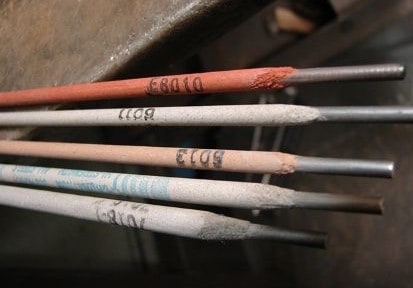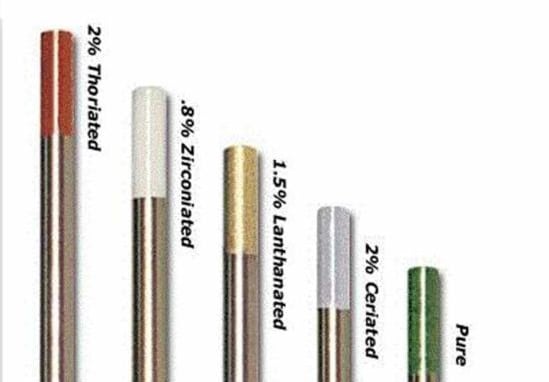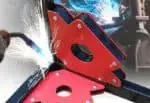 Welding rods comes in various sizes and types. There are certain things that you need to know before selecting the best possible welding rod for your work.
Welding rods comes in various sizes and types. There are certain things that you need to know before selecting the best possible welding rod for your work.
Welding rods are majorly classified into three types such as Consumable rods, Non Consumable rods and Flux rods.
Consumable rods are further divided into categories such as bare electrodes, light coated electrodes and shielded arc electrodes. Non Consumable electrodes are divided into carbon electrodes and tungsten electrodes. Tungsten electrodes come in different color codes such as brown, green, red, yellow, orange, etc according to its constituents.
Consumable Electrode: Pros, Cons, and Types
These rods are the ones that get used up easily. They get burned up slowly and need to be replaced at regular intervals. The primary reason for this is their characteristic of having a low melting point. However, these are cheap and comparatively easy to use than other rods used for welding.
These are thermally efficient and economically beneficial for those who are looking for their business to be done on a limited budget. The most commonly used materials are low alloy, nickel steel, and mild.
Consumable electrodes are further divided based on the coatings as follows:
Light electrodes: As the name suggests these have a very light coating that helps in the stability of work which lacks in bare electrodes. A combination of different materials is used for making light electrodes. They are less affected by impurities like sulfur and oxide, thereby, giving quality results.
Bare electrodes: These are somewhat difficult to handle as the arc is not much stable. Because of this feature, these are not used widely like other rods. One use of these rods is to weld manganese steel.
Shielded arc electrodes: These are used for welding heavy materials like cast iron and stainless steel. There are three kinds of shielded arc electrodes: based on the elements used:- electrodes that are made of cellulose, the ones that are made of mineral substances and the third type is the mix of the two.
Cellulose coating is composed of soluble materials like cotton and other materials like sodium, potassium, and titanium and in certain cases, added materials will also be used.
The mineral coatings consist of metallic oxides clay, sodium silicate, and other inorganic substances or their combinations.
The major difference is that while cellulose coating uses gaseous materials to protect the metal, mineral coating uses slag for the same purpose.
Shielded arc metal arc welding or stick welding as it is called is one of the most popular welding processes used because of its simplicity and versatility. It dominates the other welding processes with its capability.
Flux electrodes for a smooth welding experience
For a smooth welding process, flux rods are to be used. A shield is created when burned and this protects the weld from contamination. Based on the requirements one can choose the apt one from the variety of flux rods available.
Non Consumable electrode and its two major types
Non Consumable electrodes have a high melting point and therefore last longer than their counterparts. Materials like Carbon and tungsten are used for making these rods. The latter is expensive than the former.
However, these are not user-friendly, but the variety of ways they can be used outweighs this con. Unlike consumable electrodes, these will last longer and can be used for welding very heavy metals. These rods are used primarily for carbon arc welding and TIG welding.
What is Carbon Arc Welding?
Carbon arc welding uses an arc struck between the work piece and carbon electrode. When electricity is used this arc melts making the joint. This is the oldest welding process. It is less expensive and a high level of expertise is not needed.
The process can be easily automated with low distortion of the work piece. Cons of using these rods are that the instability in the process leading to porosity and the carbon in the rod will contaminate the weld materials with carbides.
What is TIG or GTAW?
Tungsten Inert Gas (TIG) or Gas Tungsten Arc Welding (GTAW) is the method of welding using non-consumable tungsten rods. It gained popularity in the 1940s when it began to be employed for welding aluminum and magnesium. This was a replacement for slag being used as a protective cover and therefore became a replacement for manual and gas metal arc welding.
TIG is used for high-quality aluminum and various other structural applications these days. One important requirement for TIG welding is the constant power supply as this prevents extensive high current from being drawn during a short circuit. Direct Current (DC) or Alternating Current (AC) can be used for these welding rods.
Why are tungsten rods color-coded?
Tungsten rods used for welding comes in various colors so that it is easy to identify the different types available. One needs to choose the suitable rods based on the material type to be welded, its thickness, and type of current used (AC or DC).

Pure Tungsten (Color – Green): These contain 99.50 percent tungsten and are used more widely than other alloyed versions of tungsten rods. These provide stability to AC welding for aluminum and magnesium alloys with a balanced wave. However, these are not suitable for DC welding as it does not provide a strong arc like the rest of tungsten electrodes.
Ceriated (Color – Orange): These contain a minimum of 97 percent tungsten along with 1.80 to 2.20 cerium. These are preferred due to their good ignition and reignition characteristics. Ceriated tungsten welding rods can be used efficiently for AC and DC welding. They can be considered as a substitute for thoriated rods.
Ceriated tungsten has a low arc that can start at a lower level of current and are popular in applications like thin sheet metal work orbital tube and pipe fabricating, and jobs involving small and delicate parts.
Thoriated (Color- Red & Yellow): These tungsten rods consist of the radioactive material thorium and therefore, the user needs to strictly adhere to the instructions mentioned. Warnings should be heeded while dealing with these.
The presence of thorium increases the qualities of electron emission of the electrodes. Therefore, the higher the thorium, the higher will be the benefit. They are widely used due to their less consumption rate (melting point is low) and longevity.
A minimum of 97.30 percent of tungsten will be present in these rods with 1.70 to 2.20 percent of thorium. An area where these rods outweigh their counterparts is contamination as thoriated electrodes dump only a minimal amount of tungsten into the weld puddle.
As the electrons are evenly spread during welding, it helps to maintain a sharpened edge throughout the process making these the ideal choice for welding thin steel.
Lanthanated (Color- Gold): Lanthanted rods are constituted by 1.30 to 1.70 percent lanthanum or lanthana mixed with 97.80 percent tungsten. These share the same qualities of 2 percent throated tungsten rods and hence, are stable in their working.
Lanthanated tungsten electrodes work well with both AC and DC. Like ceriated electrodes, these start at low current volume are can be used to optimize the electrode capability.
A sharpened edge can be maintained till the end of the process making it an excellent choice for welding steel. The presence of Lanthana helps in a higher current carrying capacity compared to others.
Zirconiated (Color – brown): These have a comparatively high percentage of tungsten – 99.10 percent. This is mixed with 0.15- 0.40 percent of Zirconium.
One huge advantage of using Zirconium is that it prevents spitting of tungsten and this helps in marinating stability in the work. While zirconiated tungsten rods are ideal to be used under AC it is not at all suitable to be employed under DC.
Rare earth (Color – Grey): Rare earth tungsten rods are made of rare earth oxides or a hybrid combination of different such oxides. The addition of these oxides makes the process of burning away to form new compounds.
These compounds tend to travel from a low melting point and tend to migrate to zones of high temperature. As the constituents in these rods differ based on the oxides used, users should look into them and decide which is best for their purpose.
These are suitable for both AC and DC and last longer. Like Zirconiated prevents tungsten spitting but when it comes to usage of electricity it takes a higher current than others rods of similar size.
The different types of tungsten electrodes are mentioned below based on American Welding Society (AWS) specifications for a quick understanding:
| Color | AWS classification | Defined |
| Green | EWP | Pure tungsten |
| Orange | EWPCe-2 | 2% Ceria |
| Gold | EWLa-1 | 1% Lanthana |
| Yellow | EWTh-1 | 1% Thoria |
| Red | EWTh-2 | 2% Thoria |
| Brown | EWZr-1 | 0.15-0.40% Zirconia |
| Grey | EWG | Other |
What kinds of precautions are needed to be taken while using welding electrodes?
1.) Do not bend the rods as it can damage the coating. Once the coating is gone, the use of electrodes goes in vain.
2.) Electrodes need to be kept dry at all times.
3.) Moisture destroys electrodes and therefore they need to be kept in containers whenever possible. Welding should be done in a dry atmosphere and containers can help with the same.
4.) As mentioned earlier, elements like thorium can be harmful to health, and therefore one needs to be vigilant enough not to go overboard with its usage. Make use of all safety measures needed before indulging in such dangerous works.
Now, what are you waiting for? Choose the rod for you and start your work now!






